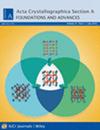柏拉图立体生成它们的四维类似物。
IF 1.8
4区 材料科学
Acta Crystallographica Section A
Pub Date : 2013-11-01
Epub Date: 2013-09-12
DOI:10.1107/S0108767313021442
引用次数: 15
摘要
本文展示了正则凸4-多面体——四维柏拉图立体的类似物——如何从仅关于柏拉图立体的三维考虑中构造出来。通过cartan - dieudonn本文章由计算机程序翻译,如有差异,请以英文原文为准。
Platonic solids generate their four-dimensional analogues.
This paper shows how regular convex 4-polytopes - the analogues of the Platonic solids in four dimensions - can be constructed from three-dimensional considerations concerning the Platonic solids alone. Via the Cartan-Dieudonné theorem, the reflective symmetries of the Platonic solids generate rotations. In a Clifford algebra framework, the space of spinors generating such three-dimensional rotations has a natural four-dimensional Euclidean structure. The spinors arising from the Platonic solids can thus in turn be interpreted as vertices in four-dimensional space, giving a simple construction of the four-dimensional polytopes 16-cell, 24-cell, the F4 root system and the 600-cell. In particular, these polytopes have `mysterious' symmetries, that are almost trivial when seen from the three-dimensional spinorial point of view. In fact, all these induced polytopes are also known to be root systems and thus generate rank-4 Coxeter groups, which can be shown to be a general property of the spinor construction. These considerations thus also apply to other root systems such as A(1)\oplus I(2)(n) which induces I(2)(n)\oplus I(2)(n), explaining the existence of the grand antiprism and the snub 24-cell, as well as their symmetries. These results are discussed in the wider mathematical context of Arnold's trinities and the McKay correspondence. These results are thus a novel link between the geometries of three and four dimensions, with interesting potential applications on both sides of the correspondence, to real three-dimensional systems with polyhedral symmetries such as (quasi)crystals and viruses, as well as four-dimensional geometries arising for instance in Grand Unified Theories and string and M-theory.
求助全文
通过发布文献求助,成功后即可免费获取论文全文。
去求助
来源期刊
自引率
11.10%
发文量
0
审稿时长
3 months
期刊介绍:
Acta Crystallographica Section A: Foundations and Advances publishes articles reporting advances in the theory and practice of all areas of crystallography in the broadest sense. As well as traditional crystallography, this includes nanocrystals, metacrystals, amorphous materials, quasicrystals, synchrotron and XFEL studies, coherent scattering, diffraction imaging, time-resolved studies and the structure of strain and defects in materials.
The journal has two parts, a rapid-publication Advances section and the traditional Foundations section. Articles for the Advances section are of particularly high value and impact. They receive expedited treatment and may be highlighted by an accompanying scientific commentary article and a press release. Further details are given in the November 2013 Editorial.
The central themes of the journal are, on the one hand, experimental and theoretical studies of the properties and arrangements of atoms, ions and molecules in condensed matter, periodic, quasiperiodic or amorphous, ideal or real, and, on the other, the theoretical and experimental aspects of the various methods to determine these properties and arrangements.

 求助内容:
求助内容: 应助结果提醒方式:
应助结果提醒方式:


